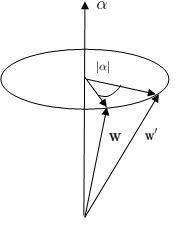Angular Momentum as a Generator of Rotations in 3D
Let us consider an infinitesimal rotation described by a vector Failed to parse (SVG (MathML can be enabled via browser plugin): Invalid response ("Math extension cannot connect to Restbase.") from server "https://wikimedia.org/api/rest_v1/":): {\displaystyle \mathbf{\alpha} \!} directed along the axis about which the rotation takes place and whose magnitude is the angle of the rotation. We then have
- Failed to parse (SVG (MathML can be enabled via browser plugin): Invalid response ("Math extension cannot connect to Restbase.") from server "https://wikimedia.org/api/rest_v1/":): {\displaystyle \mathbf{w}' = \mathbf{w} + \mathbf{\alpha} \times \mathbf{w} = \mathbf{w} + \delta\mathbf{w} }
The changes Failed to parse (SVG (MathML can be enabled via browser plugin): Invalid response ("Math extension cannot connect to Restbase.") from server "https://wikimedia.org/api/rest_v1/":): {\displaystyle \delta \mathbf w} (in the radial vector Failed to parse (SVG (MathML can be enabled via browser plugin): Invalid response ("Math extension cannot connect to Restbase.") from server "https://wikimedia.org/api/rest_v1/":): {\displaystyle \mathbf w\!} of the particle) due to such a rotation is:
- Failed to parse (SVG (MathML can be enabled via browser plugin): Invalid response ("Math extension cannot connect to Restbase.") from server "https://wikimedia.org/api/rest_v1/":): {\displaystyle \delta \mathbf w=\mathbf{\alpha}\times \mathbf w}
so
- Failed to parse (SVG (MathML can be enabled via browser plugin): Invalid response ("Math extension cannot connect to Restbase.") from server "https://wikimedia.org/api/rest_v1/":): {\displaystyle \psi\left(\mathbf{w}+\mathbf{\delta} \mathbf{w}\right)=\left(1+\mathbf{\alpha}\cdot\left(\mathbf{w}\times\mathbf{\nabla}\right)\right)\psi\left(\mathbf{w}\right)}
The expression
- Failed to parse (SVG (MathML can be enabled via browser plugin): Invalid response ("Math extension cannot connect to Restbase.") from server "https://wikimedia.org/api/rest_v1/":): {\displaystyle 1+\mathbf{\alpha}\cdot(\mathbf{w}\times\mathbf{\nabla})}
is the operator of an infinitesimally small rotation. We recognize the equation
- Failed to parse (SVG (MathML can be enabled via browser plugin): Invalid response ("Math extension cannot connect to Restbase.") from server "https://wikimedia.org/api/rest_v1/":): {\displaystyle \mathbf{w}\times\mathbf{\nabla}=\frac{i}{\hbar}\mathbf{L}}
Therefore, the infinitesimal rotation operator is
- Failed to parse (SVG (MathML can be enabled via browser plugin): Invalid response ("Math extension cannot connect to Restbase.") from server "https://wikimedia.org/api/rest_v1/":): {\displaystyle \mathbf{R}_{inf}=1+\frac{i}{\hbar}\mathbf{\alpha}\cdot\mathbf{L}}
This expression is only until the first order correction. The actual rotation operator is calculated by applying this operator N times where N goes to infinity. Doing so, we get the rotation operator for finite angle
- Failed to parse (SVG (MathML can be enabled via browser plugin): Invalid response ("Math extension cannot connect to Restbase.") from server "https://wikimedia.org/api/rest_v1/":): {\displaystyle \mathbf{R} = e^{\frac{i}{\hbar}\mathbf{\alpha}\cdot\mathbf{L}}}
In this form, we recognize that angular momentum is the generator of rotation. And we can write the equation relating the initial vector before rotation with the transformed vector as
- Failed to parse (SVG (MathML can be enabled via browser plugin): Invalid response ("Math extension cannot connect to Restbase.") from server "https://wikimedia.org/api/rest_v1/":): {\displaystyle \mathbf{w}'=e^{\frac{i}{\hbar}\mathbf{\alpha}\cdot\mathbf{L}}\mathbf{w} e^{-\frac{i}{\hbar}\mathbf{\alpha}\cdot\mathbf{L}}}
This expression of the rotation operator is also valid when the rotation angle is not infinitesimal. What's more, this equation also implies that if we have a scalar instead of Failed to parse (SVG (MathML can be enabled via browser plugin): Invalid response ("Math extension cannot connect to Restbase.") from server "https://wikimedia.org/api/rest_v1/":): {\displaystyle \mathbf{w}\!} , it would be invariant. We can also calculate the effect of the unitary operator Failed to parse (SVG (MathML can be enabled via browser plugin): Invalid response ("Math extension cannot connect to Restbase.") from server "https://wikimedia.org/api/rest_v1/":): {\displaystyle e^{\frac{i}{\hbar}\mathbf{\alpha}\cdot\mathbf{L}}} on the states:
- Failed to parse (SVG (MathML can be enabled via browser plugin): Invalid response ("Math extension cannot connect to Restbase.") from server "https://wikimedia.org/api/rest_v1/":): {\displaystyle \langle r_0|e^{\frac{i}{\hbar}\mathbf{\alpha}\cdot\mathbf{L}}\mathbf{ \hat{\mathbf{r}}} e^{-\frac{i}{\hbar}\mathbf{\alpha}\cdot\mathbf{L}}=\langle r_0|\hat{\mathbf{r'}}=r_0'\langle r_0|}
- Failed to parse (SVG (MathML can be enabled via browser plugin): Invalid response ("Math extension cannot connect to Restbase.") from server "https://wikimedia.org/api/rest_v1/":): {\displaystyle \Rightarrow \psi'(r_0)=\langle r_0|\psi'\rangle=\langle r_0|e^{\frac{i}{\hbar}\mathbf{\alpha}\cdot\mathbf{L}}|\psi\rangle=\langle r_0'|\psi\rangle=\psi(r_0')}
This is the wavefunction evaluated at a rotated point.
